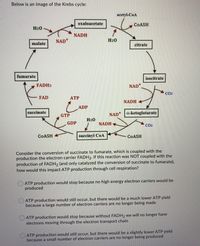
Human Anatomy & Physiology (11th Edition)
11th Edition
ISBN: 9780134580999
Author: Elaine N. Marieb, Katja N. Hoehn
Publisher: PEARSON
expand_more
expand_more
format_list_bulleted
Concept explainers
Question
thumb_up100%

Transcribed Image Text:Below is an image of the Krebs cycle:
acetyl-CoA
oxaloacetate
COASH
H20
NADH
NAD*
H20
malate
citrate
fumarate
isocitrate
FADH2
NAD*
CO2
FAD
АТР
NADH +
ADP
succinate
GTP
NAD+ a-ketoglutarate
H20
GDP
NADH +
CO2
COASH
succinyl CoA
COASH
Consider the conversion of succinate to fumarate, which is coupled with the
production the electron carrier FADH2. If this reaction was NOT coupled with the
production of FADH2 (and only catalyzed the conversion of succinate to fumarate),
how would this impact ATP production through cell respiration?
OATP production would stop because no high energy electron carriers would be
produced
ATP production would still occur, but there would be a much lower ATP yield
because a large number of electron carriers are no longer being made
ATP production would stop because without FADH2 we will no longer have
electrons moving through the electron transport chain
ATP production would still occur, but there would be a slightly lower ATP yield
because a small number of electron carriers are no longer being produced
Expert Solution
This question has been solved!
Explore an expertly crafted, step-by-step solution for a thorough understanding of key concepts.
Step by stepSolved in 2 steps

Knowledge Booster
Learn more about
Need a deep-dive on the concept behind this application? Look no further. Learn more about this topic, biology and related others by exploring similar questions and additional content below.Similar questions
- Identify the label in the correct position in the following: C-1 of acetyl CoA to malate (one cycle) 3-14C OAA + unlabeled acetyl-CoA to succinate.arrow_forwardWhich of the following statements inaccurately describes glutamate dehydrogenase? Glutamate dehydrogenase uses either NAD+ or NADP+ in a redox reaction Glutamate dehydrogenase catalyzes an oxidative deamination reaction Glutamate dehydrogenase equilibrium lies with the reductive amination of glutamate Glutamate dehydrogenase utilizes hydrolysis to release ammonium from an imine intermediatearrow_forwardDuring each cycle of ß-oxidation of fatty acid, all the following compounds are generated except NADH H20 FAD Acyl COAarrow_forward
- In the presence of O₂ and low energy status of the cell, acetyl CoA is oxidized to oxygen lactate carbon dioxide ethanol O NADHarrow_forwardMatch the following B vitamins with the roles of their coenzymes: riboflavin [ Choose ] niacin [ Choose ] pantothenic acid [ Choose ] vitamin B6 [ Choose ]arrow_forwardWhich cytochrome P450-catalyzed reaction is shown below? R-CH2NH2 [R-CH=NH] Oxidation of aromatic amines Oxidative deamination Oxidative O-dealkylation Oxidative N-dealkylation para-hydroxylation R-CHO + NH3arrow_forward
- Choose the correct identity:arrow_forwardIn the beta oxidation of linoleic acid, converting the 3, 5, 8 trienoyl CoA intermediate back to an expected intermediate for a beta oxidation substrate costs the equivalent of how many ATPs? (hint: look at the 'right side' of the figure for addressing problem 3 with linoleic acid)arrow_forwardBelow are some statements about the TCA Cycle. Which statement is true based on what we have learned in the class? Question 16 options: Oxaloacetate can be replenished from pyruvate carboxylation catalyzed by pyruvate carboxylase. The catabolism of proteins can only feed into the TCA cycle at one point, which is Acetyl-CoA. Acetyl-CoA has transporter proteins and can be transported directly from matrix to cytoplasm (for fatty acid synthesis). In TCA cycle, both Acetyl-CoA and Succinyl-CoA hydrolysis reactions are coupled with ATP/GTP synthesis.arrow_forward
- A liver cell undergoing gluconeogenesis is incubated in the presence of 14C labelled carbonic acid (H14CO3H). Soon after the incubation begins, the gluconeogenic products and intermediates from these cells are isolated. Where would you expect the radiolabelled carbon to be found? O C1 of lactate O C1 of glucose O Carbon dioxide O C3 of phosphoenol pyruvate O C1 of phosphoenolpyruvatearrow_forwardWhich enzyme is used for both the synthesis and breakdown of acetoacetate? thiolase O HMG-CoA synthase OB-hydroxybutyrate dehydrogenase O B-Ketoacyl-CoA transferasearrow_forwardRefer to the diagram of the Krebs cycle Which substance could be considered as the most “heavily used” metabolic intermediate?* Succinyl CoA Acetoacetyl CoA Acetyl CoA Pyruvic Acidarrow_forward
arrow_back_ios
SEE MORE QUESTIONS
arrow_forward_ios
Recommended textbooks for you
 Human Anatomy & Physiology (11th Edition)BiologyISBN:9780134580999Author:Elaine N. Marieb, Katja N. HoehnPublisher:PEARSON
Human Anatomy & Physiology (11th Edition)BiologyISBN:9780134580999Author:Elaine N. Marieb, Katja N. HoehnPublisher:PEARSON Biology 2eBiologyISBN:9781947172517Author:Matthew Douglas, Jung Choi, Mary Ann ClarkPublisher:OpenStax
Biology 2eBiologyISBN:9781947172517Author:Matthew Douglas, Jung Choi, Mary Ann ClarkPublisher:OpenStax Anatomy & PhysiologyBiologyISBN:9781259398629Author:McKinley, Michael P., O'loughlin, Valerie Dean, Bidle, Theresa StouterPublisher:Mcgraw Hill Education,
Anatomy & PhysiologyBiologyISBN:9781259398629Author:McKinley, Michael P., O'loughlin, Valerie Dean, Bidle, Theresa StouterPublisher:Mcgraw Hill Education, Molecular Biology of the Cell (Sixth Edition)BiologyISBN:9780815344322Author:Bruce Alberts, Alexander D. Johnson, Julian Lewis, David Morgan, Martin Raff, Keith Roberts, Peter WalterPublisher:W. W. Norton & Company
Molecular Biology of the Cell (Sixth Edition)BiologyISBN:9780815344322Author:Bruce Alberts, Alexander D. Johnson, Julian Lewis, David Morgan, Martin Raff, Keith Roberts, Peter WalterPublisher:W. W. Norton & Company Laboratory Manual For Human Anatomy & PhysiologyBiologyISBN:9781260159363Author:Martin, Terry R., Prentice-craver, CynthiaPublisher:McGraw-Hill Publishing Co.
Laboratory Manual For Human Anatomy & PhysiologyBiologyISBN:9781260159363Author:Martin, Terry R., Prentice-craver, CynthiaPublisher:McGraw-Hill Publishing Co. Inquiry Into Life (16th Edition)BiologyISBN:9781260231700Author:Sylvia S. Mader, Michael WindelspechtPublisher:McGraw Hill Education
Inquiry Into Life (16th Edition)BiologyISBN:9781260231700Author:Sylvia S. Mader, Michael WindelspechtPublisher:McGraw Hill Education

Human Anatomy & Physiology (11th Edition)
Biology
ISBN:9780134580999
Author:Elaine N. Marieb, Katja N. Hoehn
Publisher:PEARSON

Biology 2e
Biology
ISBN:9781947172517
Author:Matthew Douglas, Jung Choi, Mary Ann Clark
Publisher:OpenStax

Anatomy & Physiology
Biology
ISBN:9781259398629
Author:McKinley, Michael P., O'loughlin, Valerie Dean, Bidle, Theresa Stouter
Publisher:Mcgraw Hill Education,

Molecular Biology of the Cell (Sixth Edition)
Biology
ISBN:9780815344322
Author:Bruce Alberts, Alexander D. Johnson, Julian Lewis, David Morgan, Martin Raff, Keith Roberts, Peter Walter
Publisher:W. W. Norton & Company

Laboratory Manual For Human Anatomy & Physiology
Biology
ISBN:9781260159363
Author:Martin, Terry R., Prentice-craver, Cynthia
Publisher:McGraw-Hill Publishing Co.

Inquiry Into Life (16th Edition)
Biology
ISBN:9781260231700
Author:Sylvia S. Mader, Michael Windelspecht
Publisher:McGraw Hill Education